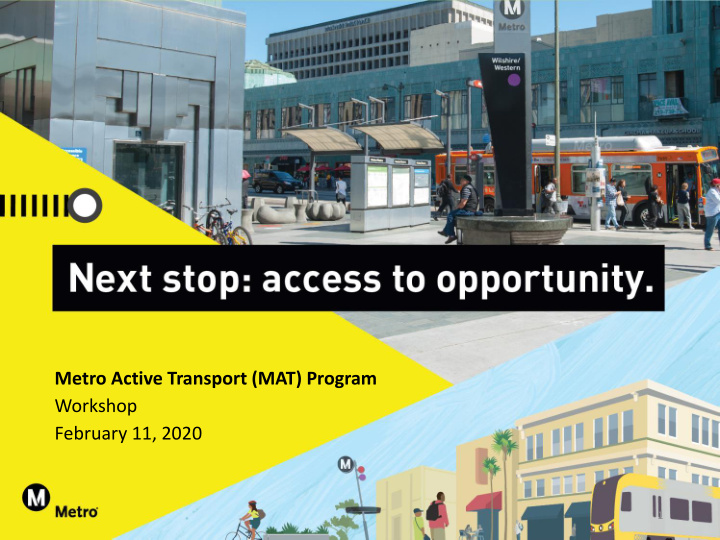



Metro Active Transport (MAT) Program Workshop February 11, 2020 1
Agenda 1. Program Overview • Cycle 1 Strategy • Screening & Prioritization • Active Transportation Corridors Category • FLM Priority Network Category • Eligibility • Metro’s Role • Evaluation & Scoring • Cycle 1 Timeline • Award Requirements • Partnership Models Discussion 2. Q&A Session 3. Breakout Sessions 2
MAT Program Overview 3
Cycle 1 Strategy Structure • 5 years • $75M • Focus on: 1) AT Corridors 50% 50% 2) FLM Priority Networks Goals • Advance key policies (ATSP, Equity) ACTIVE TRANSPORTATION CORRIDORS • Implement FLM and Corridor projects • Visible results / build momentum FLM Network • Develop and/or test project delivery and partnerships AT Corridors • Target areas of highest need 4
Screening & Prioritization Eligible Projects originated from Active Transportation Strategic Plan (ATSP): • 186 Active Transportation Corridors • 661 stations and stops Active Transportation Corridors FLM Priority Network Screening Criteria Screening Criteria • • Greater than 3 miles in length Metro Board FLM Policy • Identified 160 total corridors identified 269 stations • • Ranked by safety, equity, Ranked by safety, equity, connectivity factors connectivity factors Eligible Project List Eligible Project List • • Top 25 invited to apply Top 138 locations invited to apply 5
Active Transportation Corridors Category Objectives • Move ATSP vision into action • Create multi-jurisdictional corridors • Establish lasting partnerships • Build upon recent experience • Create pipeline for strategic investment Cycle 1 Funding • Up to 8 projects • Up to $8m each • Conceptual development through construction Note updates : • Single jurisdiction eligibility • Qualitative scoring • Corridor flexibility, cumulative 3 miles 6
First/Last Mile Priority Network Category Objectives • Move ATSP vision into action • Address existing stations and stops identified by Board Motion • Deploy efficiently in a concentrated radius (1-2 blocks) — larger projects are also eligible • Test FLM Toolkit • Pilot streamlined delivery Cycle 1 Funding • Up to 10 projects • $500k-5m each • Conceptual development through construction 7
Eligible Applicants Applicants • Cities • County of Los Angeles • Caltrans • Transit agencies • Utilities • Ports • Joint Powers Authorities* * Joint Powers Authorities must be sponsored by a public agency 8
Eligible Investments Pedestrian Traffic Calming Transit Related Bicycle Elements Elements Elements Elements* • Sidewalks • Bicycle detection loops • Speed humps • Bus pull out or bulb • Crosswalks • Bicycle-friendly • Speed cushions • Transit stop drainage grates improvements • Curb ramps • Speed tables • Bicycle-friendly track • Transit shelters • Pedestrian-activated • Raised crosswalks crossing • Boarding islands control devices • Median islands • Bike boxes • Crossing islands • Transit signage • Traffic circles • Bike parking • Curb bulb- • Transit travel outs/extensions • Class I, II, III, IV bike information paths • Leading pedestrian internal • Green colored pavement for • Pedestrian scale bikeways lighting • Bike signals/bike signal • Street priority furniture/seating *FLM Priority Network Only 9
Ineligible Investments and Restrictions • Non-Infrastructure Elements • Education • Operational Costs • Maintenance • Utility relocation and right of way acquisition limited to 10% • FLM projects outside ½ mile radius of transit/rail station • MAT Funding shall not supplant other committed funds 10
Metro’s Role: AT Corridors Two Models: 1. Metro lead initial project development through environmental phase • Project sponsors commit to in-kind staff support to Metro/consultant project team 2. Project sponsors lead initial project development final design/construction • Metro to provide project oversight through Funding Agreement Note: applicant to suggest preference in LOI, then consult post award. 11
Metro’s Roles: FLM Priority Network Flexible, Case-by-Case Metro roles may, in partnership with a Project Proposers, include: 1. Project scoping 2. Environment review 3. Design and engineering 4. Construction Note: applicant to suggest preference in LOI, then consult post award. 12
Submittal Requirements Letter of Interest • Project Description • Background Information • Project Milestone Schedule • Partnership Arrangements • Funding Strategy and/or Budget • Process Commitments • Letters of Support (optional for FLM) • Project Size Category (FLM) 13
Evaluation and Scoring Selection Process Evaluation Criteria Max Points • At least 3 evaluators per LOI Needs-based ranking 30 points • May include PAC members Project description/clear proposal of • Intention to explore project scope and components to achieve 20 points different partnerships / program outcomes delivery models Project support/partnerships 20 points • Focused on project thoughtfulness Process assurances and reasonableness 15 points • of schedule Less focused on application production value Funding strategy (AT Corridors) / 10 points Leverage (FLM) Other factors 5 points 5 points Equity Focused Communities (EFCs) (bonus) 14
Project Selection Process 3 1 2 4 Solicit Inventoried Prioritized per Select, Initiate Interest, Range of Established Projects Evaluate Eligible Criteria Submissions Projects • Equity • FLM Priority • Board Action Network (269 • Safety • Letter of on Final stations/stops) Interest • Mobility & Selection Improvements • Limited Connectivity • • Programming Active Evaluation Transportation of Initial Phases Corridors in ATSP (160 corridors) CURRENT STAGE 15
Requirements After Award Measure M Recognition: Acknowledge use of Measure M funds Complete Streets Requirement: At time of award must have supportive policy Project Reporting: Quarterly progress, establish performance indicators, and data collection ACTIVE TRANSPORTATION CORRIDORS Public Participation: Develop comprehensive Public Participation Plan (PPP) Timely Use of Funds: Project must demonstrate continuous progress 16
Cycle 1 Timeline Project Metro Board Agreements/ Project Letters of Selection Meeting Project Solicitation Interests Due Initiation Late May Anticipated Feb 18, 2020 Apr 2, 2020 2020 July 2020 Fall 2020 17
Partnership Models Innovative Partnerships • Community-based Metro organizations • Business Improvement Districts • Joint Powers Authorities Cities BIDs • Neighborhood councils • Developers CBOs Santa Anita Boulevard 18
Thank You! Questions? Website : metro.net/MATProgram Email : matprogram@metro.net 19
Breakout Sessions AT Corridors: Metro Board Room – East FLM Priority Network: Metro Board Room - West Santa Anita Boulevard 20
Recommend
More recommend